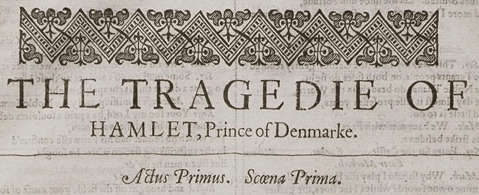
First Folio (1623) - Hamlet 1.5
Act/Scene Division

First Folio (1623) - Hamlet
1.5
* * * * * * * * * *
Acts
Though modern editions nearly always divide Shakespeare's plays into acts, among the early texts, only the First Folio has act divisions, and does not use them consistently. It is very doubtful that Shakespeare thought of his plays as having a five-act structure, or composed them in acts.

First Folio (1623)
![]()
First Folio (1623) - The Tempest 2.1
The Folio's use of Latin titles (e.g. Actus Secundus, scaena prima for Act Two, Scene One) is a reminder that act division is a feature that makes these English plays more "classical" and makes the Shakespeare Folio look more like an edition of Roman plays, such as, for example, the Renaissance editions of the Latin comedies of Terence.

First Folio (1623)
![]()
First Folio (1623) - Hamlet 2.1
* * * * * * * * * *
Scenes
Sometimes the First Folio also marks scenes.
First Folio (1623) - Hamlet 1.2 |
First Folio (1623) - Hamlet 1.3 |
However, not all scenes are marked explicitly as shown above.
Unlike acts, scenes are important subdivisions of Shakespeare's plays if they are understood as units of action during which one set of characters enters and leaves the stage. In this sense, most scenes are generally marked in the early editions, beginning with 'Enter' and ending with 'Exit' or 'Exeunt'.
 First Folio (1623) - Hamlet 1.4 |
 First Folio (1623) - Hamlet 1.5 |
In Hamlet 1.4 and 1.5 above, for example, where the First Folio lacks the scene divisions that modern editions insert, the scene breaks are instead marked by "Enter Hamlet, Horatio, Marcellus" and "Enter Ghost and Hamlet" respectively.
* * * * * * * * * *
Back to "What is a Folio?"